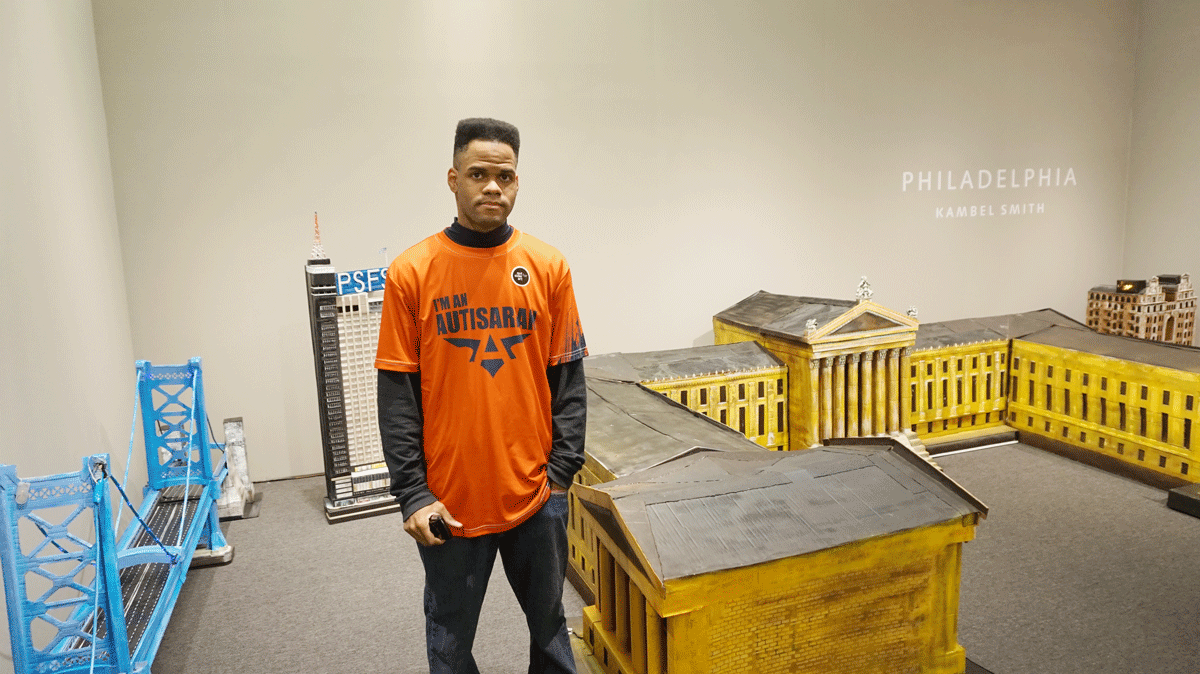[ad_1]
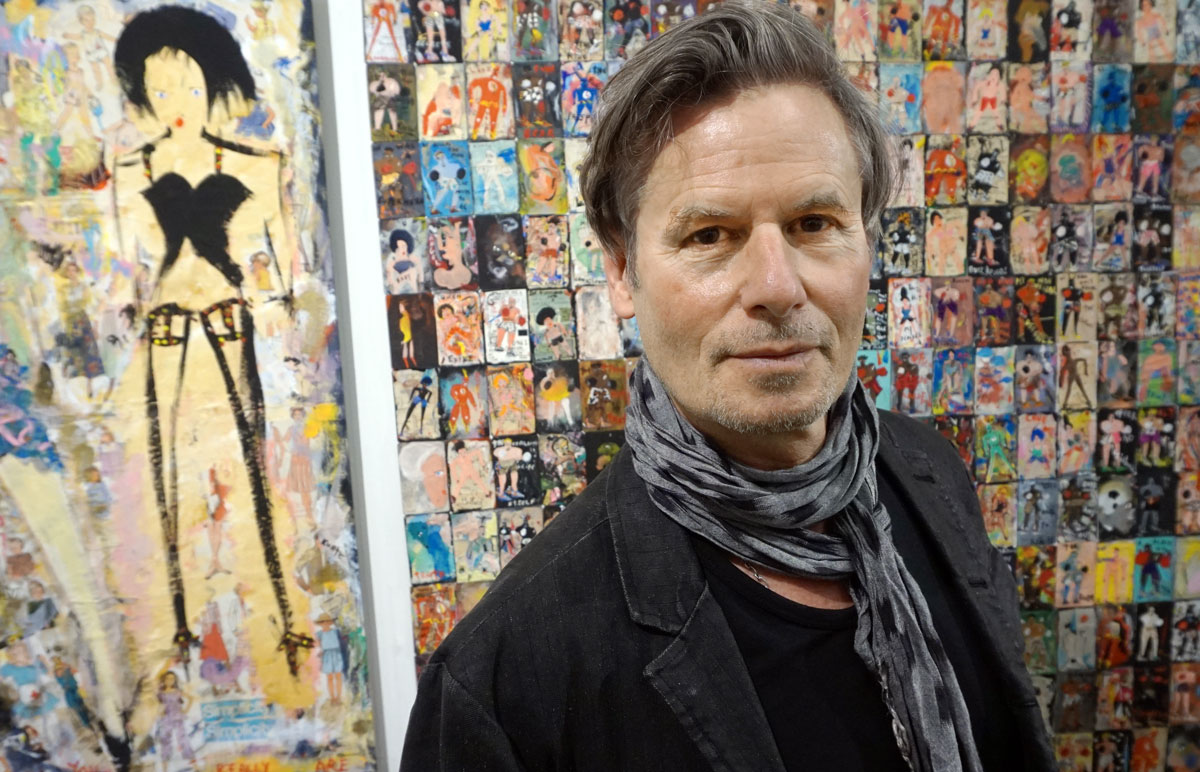
Richard Kurtz in front of his work at Esperanza Projects. The New York–based artist (and onetime driver for Martin Scorsese) sold miniature paintings on old credit cards and gift cards for $150 apiece.
KATHERINE MCMAHON/ARTNEWS
Featuring historical and contemporary works by both trained and untrained artists, the traveling exhibition “Outliers and American Vanguard Art,” which opened last year at the National Gallery of Art in Washington, D.C., focuses on moments in American art history when outsider (as in outside the mainstream) art captured the imagination of the avant-garde. The show’s debut at a major institution, closely followed by an exhibition of work by self-taught contemporary African-American artists at the Met and the Bill Traylor retrospective at the Smithsonian, announced that not only are we living in another such moment, but that—as Time Out’s Howard Halle remarked at the opening of this year’s edition of the Outsider Art Fair on Thursday—work by outliers might well be the vanguard art of our time.
And it is attracting a huge following. Just before 2 p.m., when the fair, which is in its 26th year (and 7th under current ownership) began at the Metropolitan Pavilion in New York, a long line was snaking from the front door, led by none other than Jeff Mangum, the elusive frontman of the free-thinking rock band Neutral Milk Hotel. Soon enough, the gates opened, and many of the 67 dealers on hand were reporting that the fair was noticeably more crowded than previous years.
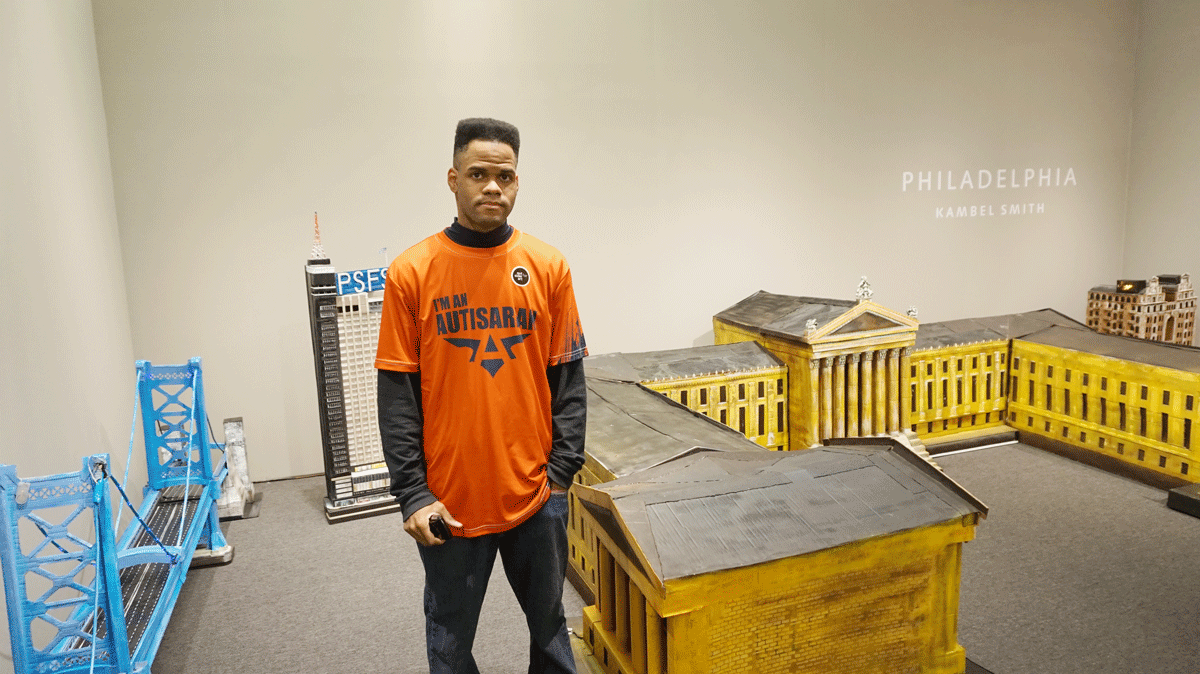
Kambel Smith with his sculptures of Philadelphia at Chris Byrne’s booth.
KATHERINE MCMAHON/ARTNEWS
Halle’s sentiment was strongly in evidence at Chris Byrne’s booth, which was devoted to autistic artist Kambel Smith’s large-scale painted cardboard models of such Philadelphia landmarks as City Hall, the Betsy Ross House, and the Philadelphia Museum of Art. Here, Smith greeted visitors in a jersey emblazoned with the name and logo of the Autisarians, the autistic super-beings about which Smith and his brother and father have made a series of comic books and an animated film.
In 2013, Smith’s father, Lonnie Smith, wrote in part, “I no longer have a child with autism. I have been given the responsibility of raising an Autisarian . . . Together we publish a book series about an autistic superhero named Survivor. Our stories are designed to encourage the search for the Autisarian in every autistic child.” How radical is that?
That sense of independent-minded adventure was also present at Almost Art Project from Beijing, which was showing extraordinary ink drawings by 71-year-old Shao Bingfeng, who inserts Western figures sourced from the internet—among them Madonna and Salvador Dalí—into traditional Chinese interiors. (On the real-life celebrity front, Susan Sarandon and Jessica Lange could be seen walking arm in arm at the fair, Sarandon pointing out to Lange a set of sculptures in the shape of a camera by Alan Constable at Dutton.)
[Tour the 2018 Outsider Art Fair in photographs.]
At Cavin-Morris and Fleisher/Ollman, blurred photographs of women taken surreptitiously in the 1960s and ’70s by Czech artist Miroslav Tichy, while unsettlingly voyeuristic, also looked newly revolutionary. Contemporaneous with surveillance photos shot by the Czech secret police, Tichy’s images both mirrored the political oppression of the time and subverted it.
Scattered among several booths is work by Purvis Young, a former prisoner and resident of the impoverished Overtown section of Miami, whose expressionist murals and paintings on found supports reflect economic hardships disproportionately suffered by African Americans as a consequence of institutionalized racism. (The artist, who died in 2010 at the age of 67, is currently the subject of a major survey at the Rubell Family Collection in his home city.)
Not far away, transgender punk-rock star Jayne County’s paintings—including a marvelous image of a group of androgynous figures endowed with huge breasts and even huger phalluses—makes an appearance at James Barron.
And a special section of the fair, curated by Zhou Yi and Brett Littman, brings together a selection of rarely-seen Chinese underground comics by the likes of such anti-conformist artists as Leng Zhiwen and Niu Liu.
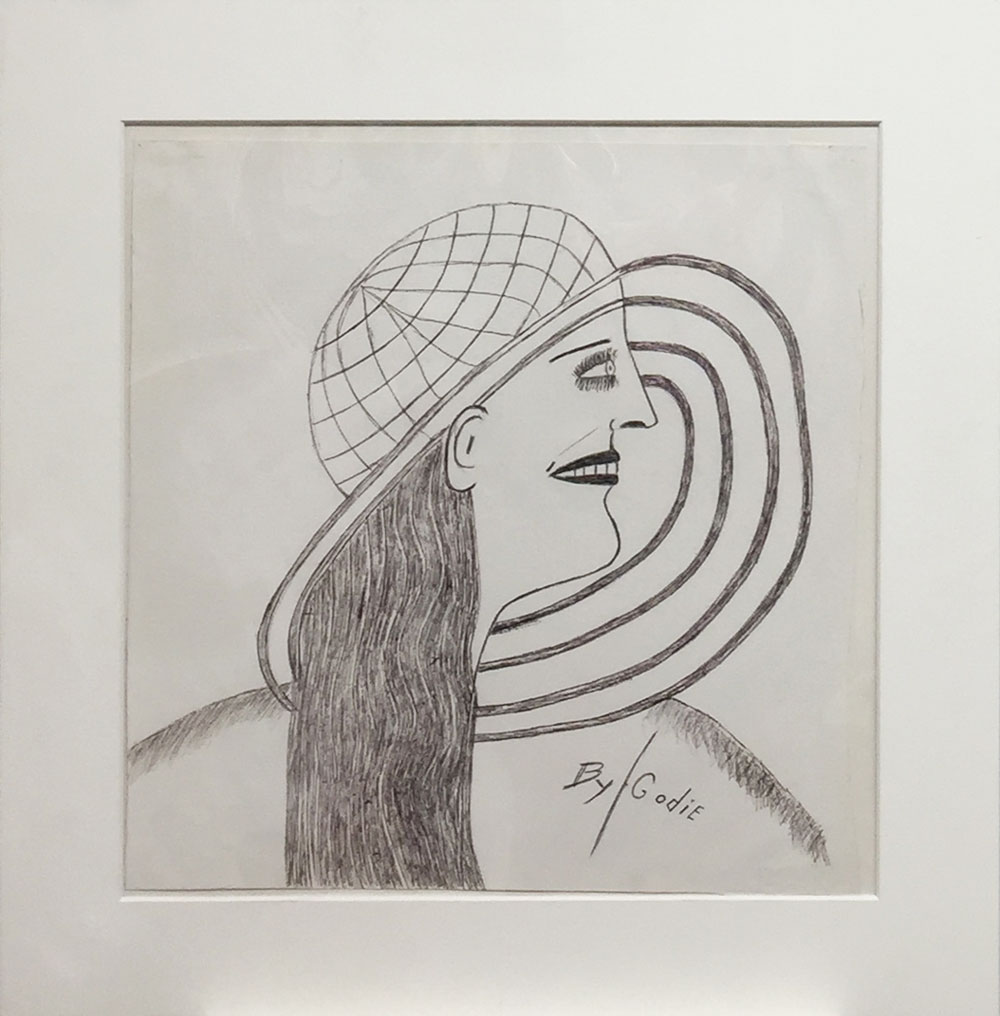
A drawing by Lee Godie at Carl Hammer’s booth.
KATHERINE MCMAHON/ARTNEWS
Perennially avant-garde are the works of Lee Godie, a homeless artist who for decades sold her drawings of glamorous women on the steps of the Art Institute of Chicago. At Carl Hammer, two of Godie’s drawings are paired with the artist’s distinctly less glamorous photo-booth self-portraits. She took them, the gallery’s director said, as visual proof that she had made the drawings, which she considered so beautiful that nobody would otherwise believe she was responsible for them. Hammer was also showing revered figures like Howard Finster, Henry Darger, and Frank Jones, and the dealer succinctly described how the fair has changed over the years. “We started here selling Henry Darger for $20,000, and today they’ll sell for hundreds of thousands of dollars,” he said.
Across the fair, potent expressions of faith, love, and the power of community serve as a welcome antidote to the polarization afflicting American life.
Queen Nancy Bell’s brilliant, semi-abstract gouaches, being shown for the first time at Fleisher/Ollman, are painted in the service of Jesus; elsewhere, Hill Gallery is presenting a grouping of memory jugs: vessels covered with clay into which are pressed small objects belonging to a deceased loved one. (Jerry Hall spent some time admiring them.) Hill should win the prize for most beautifully curated booth, in which the memory ware coexists surprisingly comfortably with such items as two early-20th-century African-American bed covers, a Navajo wood carving of a skeleton, and a vitrine filled with dozens of homemade knives confiscated from prisoners.
Big crowds are not always a sign of a successful fair, but work seemed to be moving. Yukiko Koide Presents sold all three panels of a triptych by Yuichiro Ukai for $12,000 apiece, as well as some smaller drawings and a metal sculpture by Masahiko Hasegawa for $2,000.
Creative Growth, the Oakland, California art center that supports artist with disabilities, had sold several small paintings by Dan Miller, as well as sculptures by Dina Shapiro at $950 a pop and three paintings by Lateefa Norza for $1,000 each.
Next door to Creative Growth, a selection of works by artist Traylor, a former slave who was also homeless for periods in Montgomery, Alabama, was on display with Just Folk, and two paintings of his paintings had sold—Green Critter, which was listed for $100,000, and Two Blue Birds, listed at $80,000.
At Fleisher/Ollman’s outpost, a sculpture by Sam Doyle, Fish, had sold for around $5,000, and a Finster painting, Henry Ford, Family Dogs (1982), sold for an undisclosed price. Macon, Georgia’s Mason Fine Arts also sold a Finster, From the Overcrowded World to the Heaven of Endless Space, for $8,000, alongside a piece by Samuel Gibson for $4,500, and four stone carvings by David Marshall for around $3,000 each.
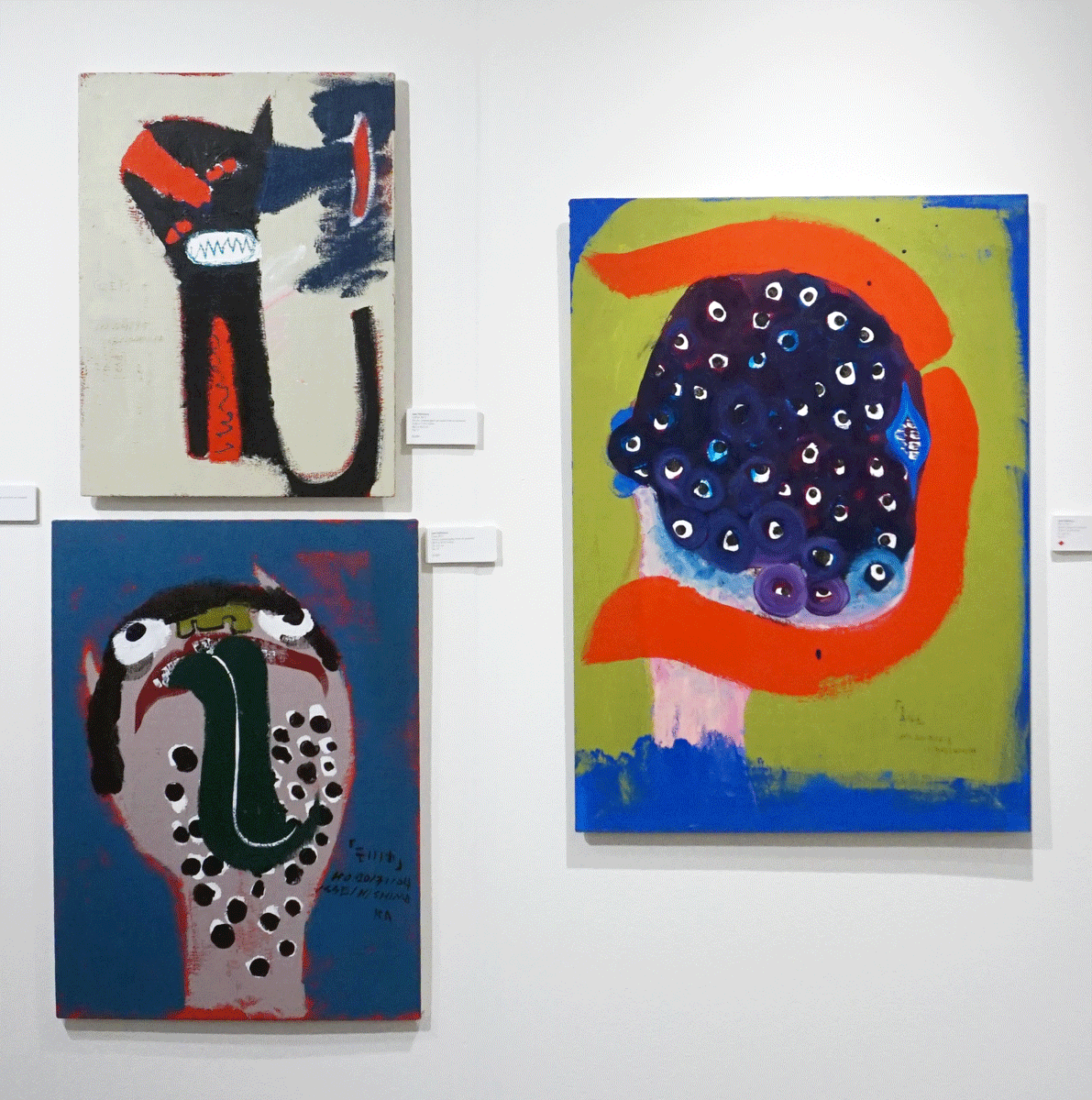
Paintings by Issei Nishimura at the Cavin-Morris booth.
KATHERINE MCMAHON/ARTNEWS
Cavin-Morris parted with two paintings by Issei Nishimura, a Japanese artist whose work has never been shown in the U.S., each for around $5,000.
Esperanza Projects is hosting work by Richard Kurtz, another artist who endured a period of homelessness, in New York in the 1970s. He used found objects such as bank bags, baseballs, money bags, and credit cards as canvases for his paintings (the last of which sold for just $150 each). The gallery’s owner, Jennifer Esperanza, as it happens, is Kurtz’s wife. “For us, it’s about the sustainability of a family and of an artist,” she said of her presentation. Their daughter Emily was on hand, too. “Alchemy is a big part of his work,” she said—a point that could be made about much of the best work at the fair. She continued, “He wants to see the things he’d encounter when he lived on the streets turn into something else.”
The Outsider Art Fair runs through Sunday, January 20. Quite a few shows of self-taught art are also on view in New York and beyond right now. Below, a few selections.
In the Galleries
– Bill Traylor at Betty Cuningham, January 19–March 3
– David Byrd at White Columns, through March 9 and Anton Kern, February 7–March 9
– Marlon Mullen at JTT, through February 17
In the Museum
– “Between Worlds: The Art of Bill Traylor” at the Smithsonian American Art Museum, through March 17, 2019 (currently closed due to the U.S. government shutdown)
– “Outliers and American Vanguard Art” at the Los Angeles County Museum of Art, through March 18, 2019
[ad_2]
Source link

